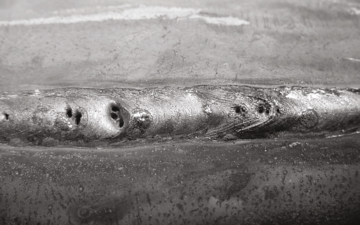Unwinding the Mystery of Porosity in Welding: Tips for Reducing Issues and Maximizing Quality
In the complex world of welding, porosity remains a persistent challenge that can considerably affect the high quality and stability of welded joints. Understanding the factors that contribute to porosity development is critical in the pursuit of flawless welds. By unraveling the secret of porosity and applying effective strategies for defect minimization, welders can raise the requirements of their work to achieve premium quality outcomes. As we look into the depths of porosity in welding, discovering the secrets to its avoidance and control will certainly be extremely important for specialists seeking to master the art of high-grade weldments.
Comprehending Porosity in Welding
Porosity in welding, a typical problem experienced by welders, refers to the presence of gas pockets or spaces in the welded material, which can jeopardize the stability and quality of the weld. These gas pockets are generally trapped during the welding process because of various factors such as inappropriate securing gas, polluted base materials, or wrong welding criteria. The formation of porosity can compromise the weld, making it susceptible to breaking and corrosion, ultimately bring about architectural failings.
By acknowledging the significance of maintaining appropriate gas securing, guaranteeing the sanitation of base materials, and maximizing welding settings, welders can considerably lower the likelihood of porosity development. Overall, an extensive understanding of porosity in welding is necessary for welders to generate premium and sturdy welds.

Common Sources Of Porosity
When evaluating welding processes for prospective quality problems, comprehending the common reasons of porosity is vital for keeping weld integrity and avoiding architectural failings. Porosity, characterized by the existence of tooth cavities or gaps in the weld steel, can significantly compromise the mechanical residential properties of a welded joint. One common root cause of porosity is incorrect protecting gas insurance coverage. Poor securing gas circulation prices or incorrect gas mixes can bring about climatic contamination, causing porosity development.
Another prevalent reason of porosity is the existence of wetness and impurities on the surface of the base steel or filler product. When welding materials are not properly cleaned or are exposed to high degrees of humidity, the vaporization of these pollutants during welding can produce spaces within the weld bead. In addition, welding at inappropriate criteria, such as excessively high traveling rates or currents, can create too much disturbance in the weld swimming pool, trapping gases and triggering porosity. By addressing these typical reasons through correct gas securing, product preparation, and adherence to ideal welding specifications, welders can reduce porosity and boost the quality of their welds.
Strategies for Porosity Prevention
Carrying out effective safety nets is important in decreasing the best site event of porosity in welding procedures. One strategy for porosity avoidance is making sure appropriate cleansing of the base metal prior to welding. Contaminants such as oil, oil, corrosion, and paint can lead to porosity, so thorough cleansing making use of ideal solvents or mechanical approaches is crucial.

Using top notch filler products and protecting gases that are suitable for the base steel and welding procedure can dramatically decrease the risk of porosity. Furthermore, keeping appropriate welding parameters, such as voltage, existing, take a trip rate, and gas circulation rate, is vital for porosity prevention.
Moreover, utilizing appropriate welding strategies, such as keeping a consistent travel rate, electrode angle, and arc length, can aid protect against porosity (What is Porosity). Ample training of welders to ensure they follow ideal methods and top quality control procedures is likewise necessary in minimizing porosity problems in welding

Ideal Practices for Quality Welds
One key technique is keeping proper cleanliness in the welding area. Thoroughly cleaning up the workpiece and bordering area before welding can help minimize these issues.
Another finest practice is to carefully choose the appropriate welding criteria for the particular materials being joined. This includes establishing the correct voltage, present, travel speed, and securing gas circulation price. Proper parameter option guarantees optimum weld infiltration, visit our website combination, and total high quality. Making use of premium welding consumables, such as electrodes and filler metals, can significantly affect the last weld quality. Spending in premium consumables can result in stronger, a lot more sturdy welds with fewer defects. By following these best techniques, welders can consistently produce high-grade welds that meet industry standards and exceed consumer assumptions.
Value of Porosity Control
Porosity control plays a critical role in guaranteeing the integrity and high quality of welding joints. Porosity, defined by the presence of dental caries or spaces within the weld steel, can dramatically endanger the mechanical residential or commercial properties and architectural integrity of the weld. Too much porosity damages the weld, making it more vulnerable to breaking, rust, and total failing under functional lots.
Efficient porosity control is important for maintaining the desired mechanical homes, such as toughness, ductility, and toughness, of the welded joint. What is Porosity. By minimizing porosity, welders can improve the overall quality and reliability of the weld, making sure that it fulfills the performance requirements of the designated application
In addition, porosity control is important for achieving the desired aesthetic appearance of the weld. Extreme porosity not only compromises the weld yet likewise takes away from its you could try this out visual appeal, which can be critical in sectors where visual appeals are necessary. Correct porosity control strategies, such as making use of the correct protecting gas, managing the welding specifications, and making certain correct cleanliness of the base materials, are essential for creating top quality welds with minimal flaws.

Conclusion
In conclusion, porosity in welding is an usual problem that can compromise the top quality of the weld. It is important to regulate porosity in welding to make sure the stability and toughness of the final item.
Comments on “Just how to Recognize What is Porosity in Welding and Improve Your Technique”